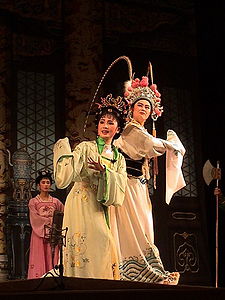- Chaoshan
-
Cháoshàn (潮汕) refers to the linguistic and cultural region in the east of Guangdong, a southeastern province of China. This region is the origin of the Min Nan dialect Teochew. The area is known as Teochew (spelt Chiuchow in Hong Kong) for most[who?] people overseas, although it also consists of the cities of Shantou (sometimes spelt Swatow) and Jieyang. It differs from the rest of Guangdong province which consists of Cantonese and Hakka speakers.[1]
Contents
Origin
The name "Chaoshan" (潮汕) is a contraction of the names of two of its administrative areas, the prefecture-level cities of Chaozhou (潮州), and Shantou (汕头).
Geography
Encompassing the cities of Chaozhou, Shantou, Jieyang and Shanwei, the Chaoshan region, with a permanent population of 13,247,400 at the end of 2007, covers an area of 10,028 km² that stretches from Shanwei on the coast to the border of Fujian.
Culture and language
This is a unique area with its own culture that is quite different from its neighbours in Guangdong and the rest of China. It does, however, share similarities to the Minnan areas just north of Chaoshan in Fujian Province. One of the main reasons for its uniqueness is its language, called Chaozhou (also spelt Teochew). It is said that this dialect of Chinese is one of the most difficult ones to master, as it has 8 tones compared to the 4 tones found in Mandarin. Music, opera, and food are further characteristics that distinguish Chaoshan people from the rest of Guangdong.
Chaozhou Dialect (潮州話), by which the Chaozhou culture conveys, is considered one of the more conservative Chinese dialects, as it preserves features from ancient Chinese that have been lost in some of the other modern dialects of Chinese. It is spoken by about 10 million people in local Chaozhou and approximately 2-5 million overseas.
Chaozhou opera (潮劇) is a traditional art form which has a history of more than 500 years and is now loved by 20 million Chaozhou natives in over 20 countries and regions. Based on the local folk dances and ballads, Chaozhou opera has formed its own style under the influence of Nanxi opera. Nanxi is one of the oldest Chinese operas that originated in the Song Dynasty. Its tunes are graceful and pleasant, full of local color. The old form of choral accompaniment still remains its special features. Clowns and females are the most distinctive characters in a Chaozhou opera, and fan-playing and acrobatic skills are more prominent than in other types of performances.
Gongfu tea (工夫茶), the 'espresso' of Chinese teas with a formidable kick, which was first sipped back in the Song Dynasty, is still flourishing and remains an important part of social etiquette in Chaozhou. If you visit a family, you can be sure of at least one round of Ganghu tea. Though it tastes bitter when it first reaches your mouth, it is the lingering aftertaste that makes Ganghu tea probably the most charming tea culture in China. Drinking Ganghu tea is in fact a process of aesthetics rather than a solution to thirst.
At the local teahouse, tea service is often accompanied with Chaozhou music (潮州音樂). String music, the gong and drum music, the ancient music of set flutes are the traditional play forms of Chaozhou music. Chaozhou string music is made up of mostly plucked and bowed string instruments, and on some occasions, wind instruments are used. The most characteristic instruments are the rihin (二弦), tihu (提胡) and yahu (all two-stringed bowed lutes), the sanxian, pipa, ruan, guzheng, and yangqin. The number of instruments and performers in the ensemble is flexible and depends on the availability of instruments and musicians to play them - but to have an even and balanced texture only one of each instrument is preferred. Chaozhou drum music includes the big drum and gong, the small drum and gong, the dizi set drum and dong and su drum and gong ensembles. The current Chaozhou drum music is said to be similar to the form of the Drum and Wind Music of the Han and Tang Dynasties. Chaozhou guzheng (潮州古筝) is also regarded a major genre of Southern style of Chinese guzheng.
Climate
A temperate climate and fresh seafood attracts many visitors to this area. The people are more relaxed than other areas of China, smoking rate is less, and work should always take the backseat to noon naps and Gong Fu tea[citation needed]. Many visitors from Hong Kong flock to the area for the great food known throughout China. The food is subtle and so is able to retain its original flavor without being tampered by soy sauce, vinegar, chili, and other sauces. Other favorites are beef balls, fish balls, rice noodle, and numerous other small treats.
Economy
In recent years, due to corruption and car smuggling in the 1980s and 1990s, the central government has chosen to slow down growth of this region even though it is still designated as an SEZ (Special Economic Zone). This has had a major effect on the lives of Chaoshan people. Business is not as vibrant compared to other areas in Guangdong and Shantou University is finding it hard to attract local high school graduates. Despite of that, new construction is prevalent and there appears to be hope in the horizon for this unique area on the coast of Southeast China. The other factor that benefits this area is the overwhelming Overseas Chinese from this area. The richest Chinese person in the world Li Ka Shing is from this region. He has invested greatly on the education and healthcare of this region.
Maps
Related links
References
- ^ James Stuart Olson (1998). An Ethnohistorical Dictionary of China. Greenwood Press. ISBN 0313288534. http://books.google.com/books?id=IOM8qF34s4YC&pg=PA42&ots=mTTFwkHc2X&dq=Chaoshan&ie=ISO-8859-1&output=html&sig=Yh1shMvRzbabFcutqA8jtqqwui8.
Wikimedia Foundation. 2010.





